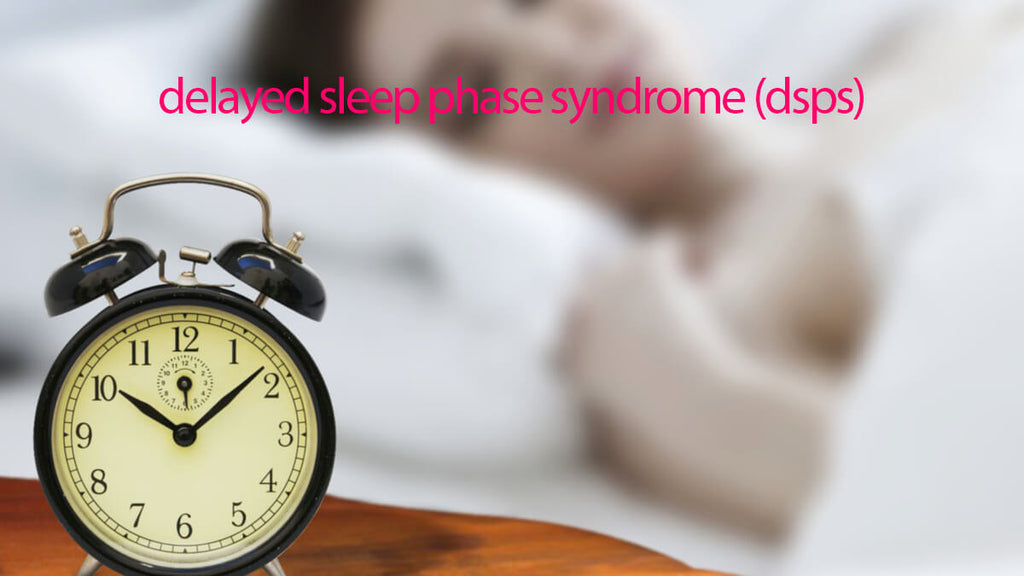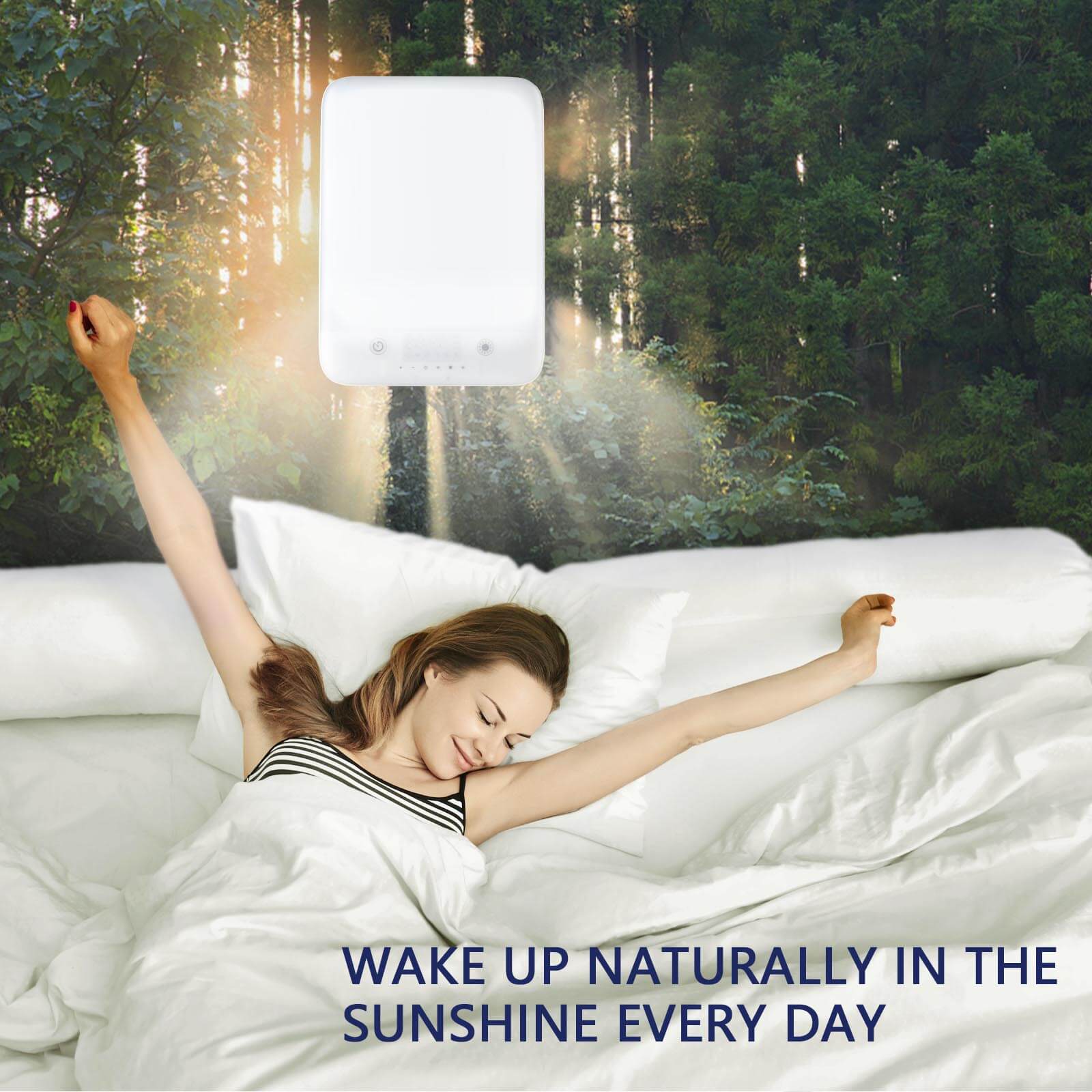How to do bright light therapy for DSPS?
Posted by GEGARY

1.what's DSPS?
Delayed Sleep Phase Syndrome (DSPS), also known as Delayed Sleep Phase Disorder (DSPD), is a circadian rhythm sleep disorder characterized by a persistent shift in an individual's sleep-wake cycle. People with DSPS typically experience a natural tendency to fall asleep and wake up later than what is considered conventional or socially acceptable.
In DSPS, individuals have difficulty falling asleep at a desired bedtime, often staying awake until the early hours of the morning. As a result, they struggle to wake up early in the morning and may experience excessive daytime sleepiness. Despite the delayed sleep schedule, the overall quality and duration of sleep are typically normal once sleep is achieved.
The exact cause of DSPS is not fully understood, but it is believed to be related to a misalignment between an individual's internal body clock (circadian rhythm) and external social or environmental cues. Factors such as genetics, lifestyle choices, and exposure to light can influence the development and severity of DSPS.
DSPS often emerges during adolescence or young adulthood and can persist throughout a person's life. It can have a significant impact on daily functioning, including difficulties in maintaining regular work or school schedules and social obligations.
Treatment for DSPS primarily focuses on shifting the sleep-wake cycle to a more desired schedule. This typically involves a combination of behavioral interventions, such as maintaining a consistent sleep schedule, optimizing sleep hygiene practices, and light therapy. In some cases, medication may be prescribed to assist with sleep initiation and maintenance.
2.How does the Lukirch light therapy box help DSPS?
The light therapy lamp box can assist in managing Delayed Sleep Phase Syndrome (DSPS) by helping to regulate the body's internal clock and promote a more regular sleep-wake cycle. Here's how it works:
Resetting the Circadian Rhythm: The light therapy lamp emits bright light that mimics natural sunlight. By exposing oneself to this light in the morning or upon waking up, it can help reset the body's internal clock and signal to the brain that it is time to be awake and alert. This exposure to bright light in the morning can help shift the sleep phase earlier, aligning it with a more desired schedule.
Advancing Sleep Phase: People with DSPS often have a delayed sleep phase, meaning they have difficulty falling asleep at a conventional bedtime. The light therapy lamp can be used in the evening or before bedtime to simulate sunset or dim light conditions, which can help advance the sleep phase. The lamp emits lower intensity or warm-colored light that signals to the body that it is nearing nighttime, helping to promote relaxation and the onset of sleep.
Establishing a Consistent Routine: Consistency is key in managing DSPS. Using the light therapy lamp at the same time every day can help establish a regular sleep-wake schedule. It can assist in training the body to associate specific times with wakefulness or sleep, making it easier to adhere to a more desired sleep pattern.
Morning Alertness: Using the light therapy lamp in the morning can help improve alertness and reduce daytime sleepiness associated with DSPS. The bright light stimulates the brain, promoting a state of wakefulness and increasing overall daytime energy levels.
Mood Enhancement: DSPS can sometimes be accompanied by mood disturbances, such as depression or irritability. Light therapy has been shown to have mood-enhancing effects by increasing the production of serotonin, a neurotransmitter that influences mood regulation. Regular use of the lamp can help improve mood and overall well-being.
Shift Work Adjustment: Many individuals with DSPS struggle with adjusting to irregular work schedules, such as night shifts or rotating shifts. Light therapy can aid in adapting to these changes by providing cues to the body's internal clock, helping it align with the new sleep and wake times required by the work schedule.
Improved Sleep Quality: DSPS can disrupt the quality of sleep, leading to difficulties in falling asleep or waking up feeling unrefreshed. The use of a light therapy lamp can help regulate the sleep-wake cycle, promoting more consolidated and restful sleep. This can result in improved sleep quality and a more refreshed feeling upon waking.
Remember, while light therapy can be beneficial for managing DSPS, it's essential to consult with a healthcare professional or sleep specialist for personalized advice and guidance on the appropriate duration, timing, and intensity of light therapy for your specific condition.
3.How should we use the light therapy lamp box?
Bright light therapy is a commonly recommended treatment for Delayed Sleep Phase Syndrome (DSPS). Here are the general steps for performing bright light therapy:
Choose the Right Light Box: Purchase a light therapy box specifically designed for treating sleep disorders. Look for a light box that emits bright light with an intensity of around 10,000 lux. Ensure that the light box is safe and meets recommended standards.
Set Up the Light Box: Position the light box at a distance of about 16 to 24 inches from your face. The box should be angled slightly above your line of sight, so the light shines indirectly onto your eyes. Make sure the light is directed towards your face without directly looking into it.
Exposure Duration: Start with an exposure duration of about 30 minutes to 1 hour, depending on the specific recommendations from your healthcare professional. Some individuals may require longer exposure times. During the exposure, engage in activities like reading or working, but avoid looking directly at the light.
Morning Exposure: Begin your light therapy session in the morning upon waking up. This helps to reset your circadian rhythm and signal wakefulness. Consistency is key, so try to maintain the same exposure time each day.
Evening Avoidance: In the evening, it's important to minimize exposure to bright light to support the shift towards an earlier sleep phase. Avoid bright screens (e.g., smartphones, tablets, computers) and bright overhead lighting at least one to two hours before your desired bedtime.
Maintain a Sleep Schedule: Establish and maintain a regular sleep schedule to complement the effects of light therapy. Go to bed and wake up at consistent times each day, even on weekends or days off.
4.Expert research and recommendations:
Light therapy, also known as bright light therapy or phototherapy, has been extensively studied and used for various sleep disorders, including Delayed Sleep Phase Syndrome (DSPS). Here are some key points regarding expert research and recommendations:
Effectiveness of Light Therapy: Research has shown that light therapy can be effective in regulating circadian rhythms and improving sleep patterns in individuals with DSPS. Exposure to bright light in the morning and avoidance of bright light in the evening can help adjust the sleep-wake cycle and promote earlier bedtimes and wake-up times.
Light Intensity and Duration: The recommended light intensity for light therapy is typically around 10,000 lux. Exposure durations can vary but commonly range from 30 minutes to 2 hours, depending on individual needs and specific treatment plans. However, it's important to consult a healthcare professional or sleep specialist for personalized recommendations.
Timing of Light Exposure: For DSPS, light therapy is usually recommended in the morning upon waking up to advance the sleep phase. It's crucial to establish a consistent routine and maintain regular exposure to light at the same time each day to entrain the circadian rhythm effectively.
Safety Considerations: Light therapy is generally considered safe when used as directed. However, certain precautions should be taken, such as avoiding direct exposure to the eyes and following manufacturer instructions. Individuals with specific medical conditions or taking medications that can make the eyes more sensitive to light should consult their healthcare provider before starting light therapy.
Professional Guidance: It is highly recommended to seek guidance from a healthcare professional or sleep specialist experienced in treating sleep disorders, including DSPS. They can provide personalized recommendations, monitor progress, and ensure that light therapy is integrated effectively into an individual's overall treatment plan.


